Having been invited to give an account of the handwritten documentation on Macau and China kept in Évora's Public Library and Archives, I classified, checked and reclassified all samples concerning this subject. I compiled a catalogue comprising eighty-eight pages, to be published by the Review of Culture in the near future.
This is therefore a summary of what I found. I grouped all the different themes and have focused on previously unreleased documentation.
Most of the samples were referred to in Book I of Catalogo dos Manuscriptos da Bibliotheca Publica Eborense, by Joaquim Heliodoro da Cunha Rivara (Lisbon, Imprensa Nacional, 1850). However, some of them were in the "Fundo Rivara" manuscripts in a catalogue entitled Os Reservados da Bibliotheca Publica de Évora, by António Joaquim Lopes da Silva Junior (Coimbra, Imprensa da Universidade, 1905), in the hand-written file of "Novos Reservados" and in the typed inventory of "Fundo da Manizola" which comprised hand-written samples bought from the heirs of the Viscount of Esperança. In addition to the above documents, there are some previously unreleased maps which are now presented and described for the first time ever. In this case, I decided to include those rare and interesting printed samples as well.
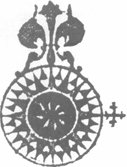
The documents studied date to the period between the sixteenth and nineteenth centuries. However, many of them refer to events which occurred before this period. In some cases, these references date back to the origins of Macau and the Portuguese incursion into China.
As to the maps, there are samples from the sixteenth to the twentieth centuries and only those prior to the twentieth century are studied because the latter are well-known.
Upon studying the manuscripts and maps, I came to the conclusion that they referred to the following major groups:
1 - History of the City of Macau
1.1 -General
1.2 - Fortresses and Artillery
1.3 - Population
1.4 - Expeditions and Trade
1.5 - Relations with China
2 - History of Christianity in Macau and China
2.1 - Macau Episcopacy
2.2 - Madre de Deus College
(of the Society of Jesus)
2.3 - Chinese Myths and Customs
seen by Christianity
2.4 - Missions in China
3 - Personalities related to Macau and China
4 - Maps
The documentation on the History of Macau covers historical works and government documents. I found seven historical works reporting events, describing circumstances or giving broad accounts, sometimes going as far back as the origins of the city.
I also found documents on the city government, referring mostly to the period of Captain General D. Francisco de Mascarenhas; among them are royal charters and decrees, administrative rules, permits and documents from the City Council.
Many manuscripts refer to the conflict between China and Macau over fortresses and artillery. Most of them date to 1624 and 1625, the period in which China forced the destruction of the walls erected by the Portuguese, which was the cause of a serious row between the City Council and the Captain General. There are also documents on the source and the amount of money spent on the fortresses and prisons in different periods. I also found a very interesting contract for the casting of artillery signed between D. Francisco de Mascarenhas, Quinquo and Hiaoxon.
On studying the population of Macau, I collected documents referring to the population existing in the city in 1625 and the slavery and rebellion in 1624. According to one of those documents, there were eight hundred and forty inhabitants in 1625, four hundred and thirty seven of whom were Portuguese who had settled in Macau, while four hundred and three were Chinese who had converted to Christianity. There is an indirect reference to slavery in an order given by the Captain General, whereby he stated that: nobody should buy coolies from Christians without permission or orders from the magistrate in order to find out the conditions of their captivity (1625), and that a six year old coolie named Achon, who was 'deposited' in Macau, was given to the mandarin (1626). In 1730, Father Caetano Lopes, of the Society of Jesus, missionary to China and representative to Rome on behalf of the Japanese Province, claimed to His Majesty that the Chinese taken as slaves should be released. In general, from 1623 to 1625 the situation among the population was not peaceful, as shown by various documents.
Regarding expeditions and trade, I have included documentation on various problems related to this subject: the Spanish were banned from going to the places [...] where the Portuguese had trade and sailing rights; the dispute between the Captain General and the City over the expedition to Manila; the prohibition of dealings with the Japanese; limitations on the trade of certain goods such as silk and silver, and the overall conditions of the Eastern Trade. Samples cover the period between the sixteenth and eighteenth centuries.
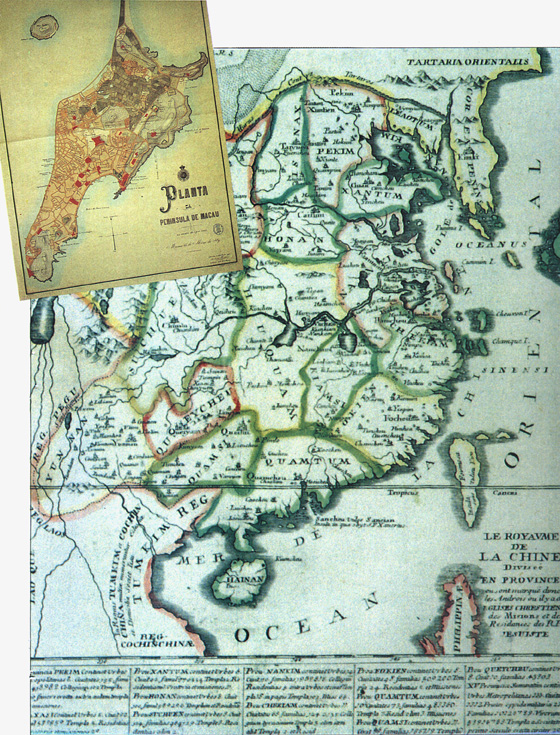 Map 4
Map 4
Moving onto the subject of relations with China, I have not found any major conflicts and that may be due to the tacit acceptance of the huge power displayed by the grand neighbour. There were, of course, minor things like the demand for an explanation for an assault on and the theft of woodwork from the mandarin's harbour house, and the reaction against the idea of a 'tribute' raised by the Chinese viceroy.
The second major group of documents deals with Christianity in Macau and China. This group features the largest number of documents. It comprises manuscripts concerning the government of the Macau Diocese, the Madre de Deus College of the Society of Jesus, Chinese myths and customs and their relationship with a new culture and religion, and also the missions in China.
Documentation on the Macau Diocese refers to D. Diogo Valente (former Bishop of Japan), the conflict that erupted over Father António do Rosário's intention to become Governor of the Diocese, and the election of Father Adriano da Cunha as Governor of the Diocese.
There is only one booklet which dates to the late eighteenth century, concerning the Madre de Deus College of the Society of Jesus. It is an interesting document because it tells the history of the college from its inception, as well as the activities of the Jesuit priests in China, Japan, Cambodia, Laos, Cochin-China and Siam.
Regarding the confrontation of Chinese rites and customs with Portuguese customs and Christianity, it was unfortunate that I could find only three documents referring to this particular area of interest.
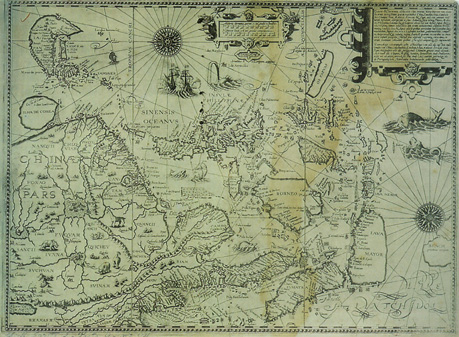 Map 1
Map 1
Most of the documentation studied deals with the missions in China and the variety is very wide. In general, it refers to the attempts made to establish Christianity in China, the visit the Patriarch of Alexandria paid to China in 1720, the situation of the various Christian organizations, persecution of priests and proselytes and considerations concerning the best way to establish Christianity in several areas.
The search I made revealed some documents relating to personalities who were connected with this subject, such as the Bishop of Macau D. Frei Marcelino Jose da Silva, the Bishop of Peking D. Frei Alexandre de Gouveia, Father Frei António da Purificação, Ambassador Alexandre Metelo de Sousa e Meneses, and Governor D. Francisco de Mascarenhas.
The documents concerning the clergy dealt mainly with their role in the situation of Christianity in China, rather than with their biographies. Therefore, I have included these documents under the relevant chapter.
However, regarding Ambassador Alexandre Metelo de Sousa e Meneses and Governor D. Francisco de Mascarenhas, there were in fact some documents which dealt only with their own personal activities.
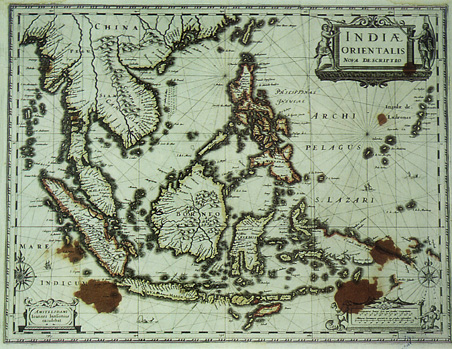 Map 2
Map 2
I found samples relating to the embassy that Alexandre Metelo de Sousa led to the Emperor of China in 1726 and 1727. There is a thick volume on D. Francisco de Mascarenhas, featuring original papers about his life. This seventeenth century nobleman and soldier, son of D. Nuno de Mascarenhas, rendered military service in Flanders and Germany, and was later sent to the East where he then became Governor and Captain General of Macau. Upon returning to Portugal he was appointed Viceroy of India in 1628. However, his journey to India was so terrible that the ship was forced to run aground, at which point Mascarenhas gave up his job. Later, he moved to Madrid where he was appointed a member to the Council of Portugal and to the State Council.
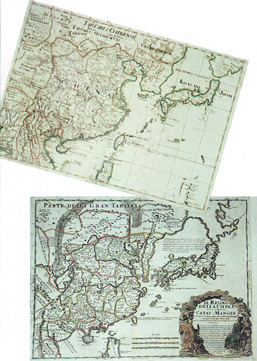 Map 3
Map 5
Map 3
Map 5
In addition, there are two small groups featuring documents which deal with José Maria de Sequeira and João Ferreira Pinto, both public officers in Macau in the nineteenth century. In the first case, I found samples related mainly to the government of the territory; and in the second case I found letters written to Joaquim Heliodoro da Cunha Rivara, with comments on daily life.
Bearing in mind that cartography is important and that the cartographic material on Macau is not widely known, I checked all maps and plans that exist in the Library, even the printed and more recent ones. I took into consideration both classified and reserved documents. As stated earlier, I excluded those documents printed in the twentieth century because they have been widely circulated.
Given the importance of this documentation and the great quality and interest of some of the examples, I will discuss them one by one.
I found the following maps of China in general:
1- Printed map dated 1595 with the following captions: Henricus F. ab Langren Sculpsit and Arnoldus F. ab Langren delineavit.
Interestingly, this Dutch map was based on a previous Portuguese map of which no identification is given; one can see the many place names and remarks in more or less correct Portuguese (refer to map 1).
2- Printed map entitled Indiae Orientalis Nova Descriptio with the following caption: Amstelodami Ioannes Ianssonius excudebat.
It features Dutch, Portuguese and Spanish place names. Several coastal areas are printed in sepia and pink. It represents only one section of South China, but it does not include Macau (refer to map 2).
3- Portuguese manuscript map without a title, date or name of author.
It is very detailed and shows the names of Chinese Provinces and many place names. It mentions Macao of the Portuguese.
It features coastal areas painted in green and borders in pink (refer to map 3).
4- Printed map with the following title: Le Royaume de la Chine Divisée en Provinces ou sont marqué dune les Androis ou il y a des Eglises Chrestien des Misions et des Residances des R. P. Jesuiste.
It features the division of Chinese Provinces and many place names. Given the text, it seems to date to the seventeenth century. Place names are in Latin and remarks in Latin and French. Coastal areas and divisions are highlighted in green, pink and yellow (refer to map 4).
5- Printed map entitled Il Regno della China detto presentemente Catay é Mangin diviso sopra le Carte piu esatte nelle sue Principali Provincie da Guglielmo Sansone data in Luce da Paolo Petrini in Napoli... I'anno 1717.
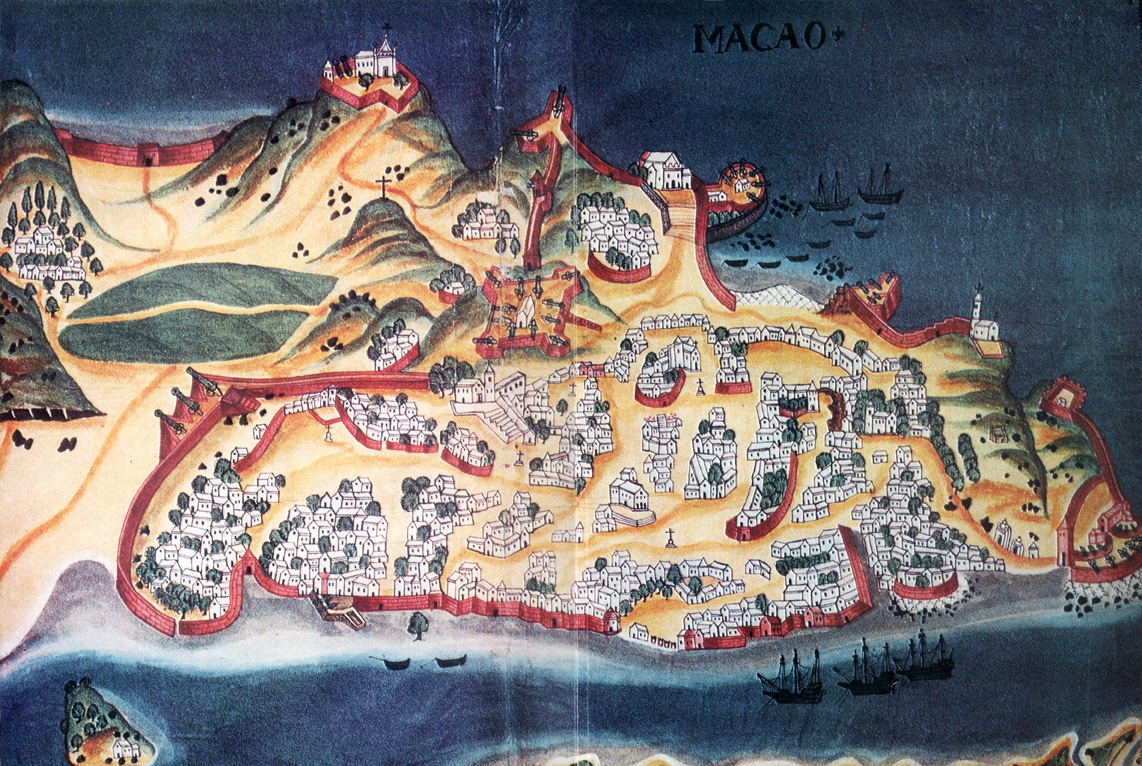 RC POSTER
Map of Macau by Pedro Barreto de Resende in Livro das Plantas de todas as Fortalezas, Cidades e Povoações do Estado da Índia Oriental (1634, António Bocarro)
RC POSTER
Map of Macau by Pedro Barreto de Resende in Livro das Plantas de todas as Fortalezas, Cidades e Povoações do Estado da Índia Oriental (1634, António Bocarro)
It shows the Chinese Provinces and many place names. It is painted in green, yellow, brown and red on the iconographic area next to the title, coastal areas, province divisions and borders (refer to map 5).
Of particular interest are the following plans of Macau:
1- Printed plan (xylograph) with the caption Macao. It shows the peninsula with its walls and buildings. Possibly, it is a page of an atlas or collection, due to the number 362 written in the top left comer.
Most likely, it dates to the sixteenth century, due to its iconographic features and the lack of St. Paul's College (refer to plan 1).
2- Manuscript plan of the Macau Peninsula featuring its fortresses, monuments, houses and ships. It is painted in blue (sea), pink (fortresses), yellow (ground), green (areas with vegetation) and brown (rocks). Its title Macao is in the top right comer.
Its author is Pedro Barreto de Resende and it is included in a book entitled Livro das Plantas de todas as Fortalezas, Cidades e Povoações do Estado da India Oriental by António Bocarro. Most likely it dates to 1634 (refer to plan 2).
3- Plano Hydrografico e em parte Topografico da Cidade de Macao levantado por ordem superior por Joaquim Bento da Fonseca em 1808 including Plantas extriores de Fortificações (A chart showing the coastal areas and city of Macau). Manuscript painted in green and red, featuring very detailed captions (refer to plan 3).
4- Planta da Península de Macau dated Macau, on the 15th of March, 1889.
Reduced and drawn by António Heitor. The colours have been machine printed (refer to plan 4).
Despite the many documents I found and the subjects on Macau that help to explain a lot of things, very little is meaningful if taken separately. This data will bear its full meaning only if analyzed along with all the documentation that is kept in local and overseas archives and libraries.
With the work in hand I do not wish to present any final interpretation of the History of Macau. Instead, my intention is to present a set of unknown documents, indicate new investigation fields to interested parties and provide researchers with research resources.
There are, however, some very interesting documents but unfortunately they cannot be read here in their entirety. Nevertheless, I am going to present some excerpts from Descrição da Cidade do Nome de Deos da China included in the book entitled Livro das Plantas de todas as Fortalezas, Cidades e Povoações do Estado da India Oriental... by António Bocarro. Also attached is the relevant plan (nº 2) by Pedro Barreto de Resende, which is an outstanding synthesis of the History of Macau until 1634.
Description of the City of the Name of God in China
The city of the Name of God is located twenty two degrees North, at the end of a peninsula on the Chinese coast. It is in the province of Canton, which is one of the fifteen local provinces of China. This piece of land is called Macao by the Portuguese and the locals. The peninsula is one league long and four hundred paces wide. The city is half a league long and in the narrowest and widest areas it is fifty paces and three hundred and fifty paces respectively. It is surrounded by two seas on the Eastern and Western sides. It is one of the most important cities in the East, thanks to its wealth and abundant, precious goods, as well as its inhabitants who are the wealthiest in this State.
In the year fifteen hundred and eighteen the Portuguese reached China for the first time, thanks to an embassy sent by King Manoel. They called at several ports of this kingdom but finally stopped at the port and island of Sancheu. It was in this city that they made the first settlement and it was also here that St. Francisco Xavier, second apostle to India and the city patron, passed away in 1552. In 1555, all transactions moved to the island of Lampacao. In 1557, they moved to this port of Macao where, thanks to trade and commerce, a numerous population developed. In 1585, under the rule of D. Francisco Mascarenhas, Viceroy of India, His Majesty upgraded it to a city with the title of 'Name of God'. His Majesty conferred upon it the colours of the Cross of Christ and other liberties similar to those of the city of Évora. This is the gate through which the apostle St. Thomas entered China, coming from India by sea. It is also through this gate that, brought by the missionaries of the Society of Jesus, the Gospel reached this empire, Japan and Cochin-China.
This city has eight hundred and fifty Portuguese and their children who are stronger and healthier than anybody else in the East. They all own six slaves, of whom the best nationalities are Caffres. The slaves paddle their small boats to the outlying islands to amuse themselves, but their owners have larger ones as well, which can be used for other purposes, such as their protection and for the service of His Majesty.
In addition to these Portuguese people, the city has other inhabitants, locals and Christian Chinese who are called 'Jurubassas' and form the largest community, and people of other nationalities, all of them being Christian. The Portuguese and the others have very good weapons, rifles, spears and so forth. Almost every Portuguese owns racks of six or twelve muskets and flints, and as many spears, which are used to decorate their houses as well because they are made of gold.
This city also has a lot of Portuguese sailors, pilots and boatswains (some married in Portugal, others still single) who sail between Japan, Manila, Solor, Makassar and Cochin-China. Over one hundred and fifty of these men do not want to go to Goa because they are afraid of either being caught for any crime committed, or recruited to work for His Majesty. There are many single and very wealthy merchants who are on the run for the same reasons.
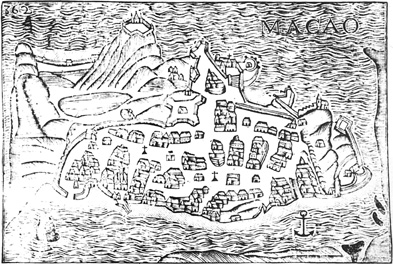
Plan 1
This city does have a Captain General who rules the Territory with help from one hundred and fifty soldiers, comprising two infantry captains and two second lieutenants, two sergeants, two corporals and an assistant, one magistrate and one bailiff. The magistrate earns one hundred thousand 'reis' paid in Malacca.
The city had also a bishop who passed away and is yet to be replaced, who earned two thousand 'xerafins' paid in Malacca.
Santiago Fortress
With regard to fortresses, this city features the Santiago Fortress right at the harbour entrance. This fortress is one hundred and fifty paces long and fifty-five wide, forming a beautiful platform five fathoms above sea level, with a wall twenty-eight spans wide. Its height is measured up to the parapet which is only three spans above the platform. Therefore, it is very difficult to protect it from people and artillery fire. In the middle of the square there is a cistern in the rock which can hold three thousand barrels of water. There is enough accommodation for one captain and sixty men, and in the basements there is room for provisions and ammunition. At the entrance on the pagoda side, there is a large and nice house. This square is topped by another one where they keep heavy artillery as well. Facilities for the captain and soldiers are on the top square. This fortress by the shore features a wall along the hill ending in a house which served as sentry post when the Captain General used to live here.
Nossa Senhora do Bom Parto Fortification
This fortification is small and triangular. It is able to house ten or twelve cannons...
Nossa Senhora da Penha de França Fortification
This small fortification is located on a hill and houses two 'sagres' cannons, each of which fires seven-pound iron balls.
S. Francisco Fortification
This fortification is oval-shaped and features six metal cannons [...] Nearby there is a platform with a culverin on it which draws thirty five pound iron cannon-balls. This is the largest cannon in the city.
On Praia Grande there is a platform with a metal cannon which fires eighteen-pound iron bullets.
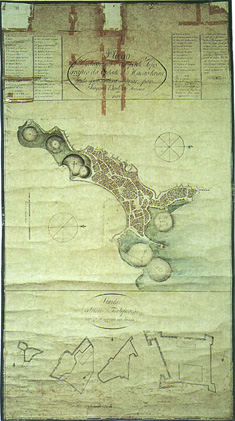
Plan 3
Nossa Senhora da Guia Fortification
Nossa Senhora da Guia Hill is the highest hill in the city and it features a fortification with five cannons on top... On this hill there are facilities for a company of soldiers and a water cistern. But as it overlooks the S. Paulo Fortress it is better to knock it down and the Chinese have agreed to do it for seven thousand taels.
S. Paulo Fortress
The most important fortress in the city is the S. Paulo Fortress, the residence of all Captain Generals. They also call it Madre de Deus, after the hill which overlooks the city; on its peak there is a wall twenty spans wide on foundations of marble up to six spans above ground level. Then the wall is made of earth and straw beaten by beaters; it is much more resistant than stone because it does not get so damaged (walls made of earth and straw are so hard that all houses in the city are built this way; in order to open windows in them after they have been built, they use iron picks and a lot of hard work is required). The wall gets narrower in proportion to their slope; the fortress is square and features a one hundred-pace square which is surrounded by walls as long as the square sides; in the four corners they form four strongholds like buttresses. Above, in the middle of the square, there are four rows of houses for generals and soldiers, a three storey tower with artillery on each level. Eighteen heavy artillery cannons are distributed among the four strongholds.
Inside the fortress there is a guard corps at the main entrance. One can go up to the hill by either side of the wall; hidden in the wall is ammunition enough to withstand any war (though not a siege of over two years in view of the large quantities of powder this heavy artillery requires, even though the city is able to produce it).
The situation in terms of food is not as good because the city depends on China and if the Chinese have anything against us they cut the supplies and there is nowhere else the Macau citizens can get the food. Supplies could be got in Cochin-China, a hundred leagues southeast of Macau, and also from some neighbouring islands since they only have cattle, pigs, chickens and some birds.
The city walls were nearly completed by D. Francisco Mascarenhas, the first Captain General who ordered the works. But being very suspicious, the Chinese had most of them knocked down, especially those facing China because they believed they had been built against them. Only those walls facing the sea were kept untouched; a palisade was also left on Cacilhas beach where the enemy had attacked the city. These walls are two fathoms high up to a parapet, and eight spans wide. However, as the ground level is different in several sections, the walls have different heights because they were supposed to run at the same level. The walls are made of earth and straw, a mixture which becomes very hard after compaction. The Praia Grande platform features an eighteen pound cannon and two 'sagres' cannons which use seven pound bullets in the S. Pedro stronghold, and an eighteen pound cannon in the S. João stronghold.
This artillery stock features four more twenty-five-pound metal 'trabuco' cannons, three seven-pound iron cannons, five bronze 'falcões' cannons, three bronze 'berços' cannons, two iron 'falcões' and one iron 'trabuco' which can be placed anywhere within the city. All in all, Macau has seventy-three cannons made of iron (not to mention those owned by individuals and His Majesty).
This city has one of the best iron and bronze foundries in the world, thanks to the Viceroy Count of Linhares, and it makes cannons for the state at very reasonable prices. This enables us to clear the Singapore Strait which is full of Dutch during the monsoon season.
The city paid for the above-mentioned artillery, walls and fortresses without any contribution from the Royal Finances. At the time, it owned the Japan route almost entirely, especially the tax which now amounts to eight per cent of all goods sent to Japan; in former times that tax amounted to three or four per cent and the return was also very high.
This article is only a brief description of the documented material on Macau. The remaining material is of great interest and offers many opportunities for fruitful research..
Presentation given at the seminar on the fifth Centenary of the Discoveries, held at the National Museum in Évora, on November 12th, 1988, under the auspices of the D. João de Castro Institute.
* Director of Évora's Public Library and Archives
start p. 31
end p.